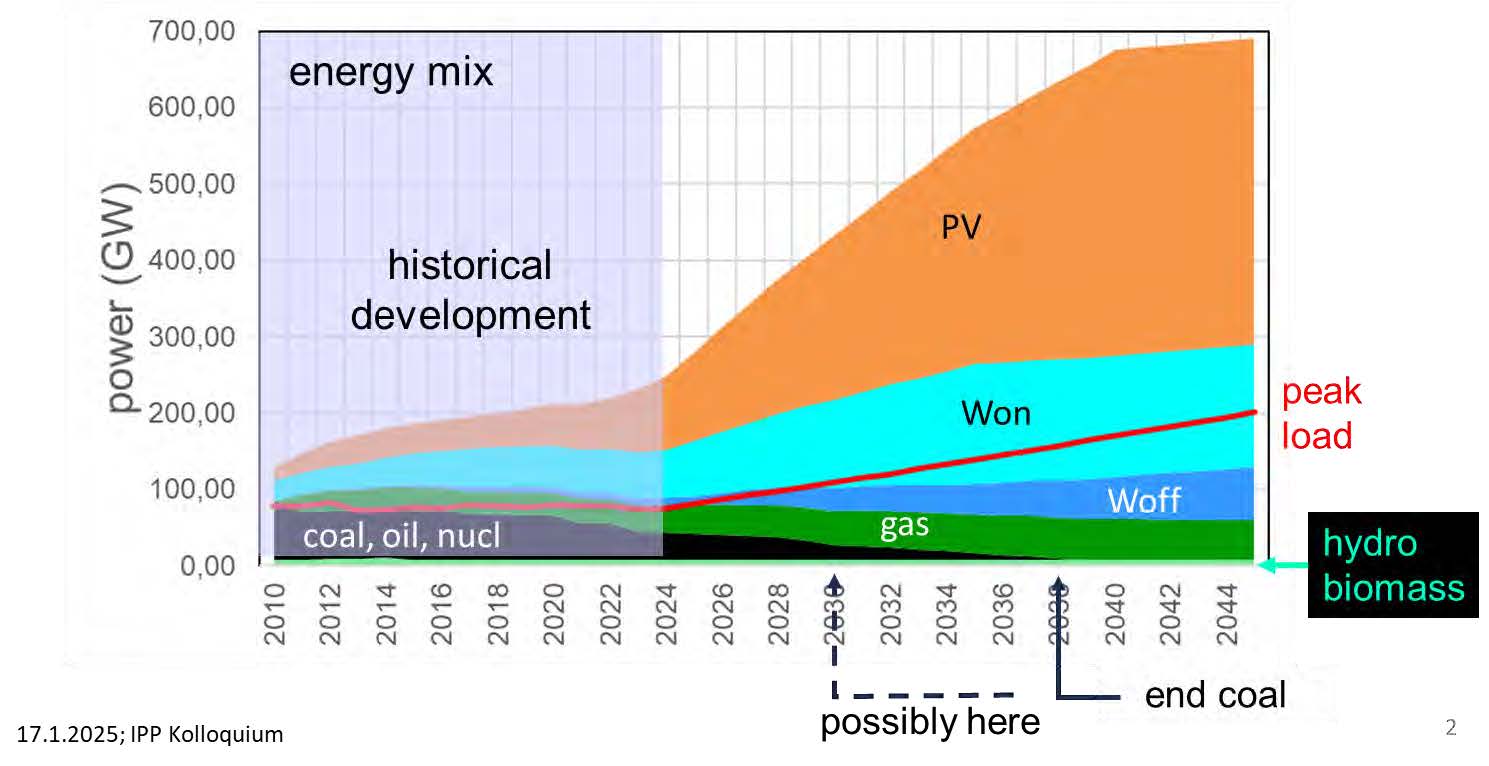par Professor Doctor Friedrich Wagner
Max-Planck-Institut für Plasmaphysik
avec son aimable autorisation
Introduction
This lecture was given at the colloquium of my institute, the Max Planck Institute for Plasma Physics, on 17 January 2025. Since my retirement in 2008, I have been trying to analyse the energy transition in Germany. The initial motivation was to find an answer to the question of whether fusion research – my field - is still justified in view of the enormous expansion of renewable energies, especially wind power and photovoltaics, in Germany. I realised that I could not find an answer to this question in the existing literature because many publications were driven by political interests. Therefore, I started to do my own research. My presentation is an interim report on the current status of the energy transition, which uses natural forms of energy to supply a highly industrialised country in the middle of Europe with electricity.
Summary and conclusions:
In this presentation I will discuss the weather dependencies of renewable electricity generation and draw some conclusions. Because of the volatility of wind and PV electricity, two separate supply technologies are needed:
(1) spontaneous electricity from wind and PV will be cheap - possibly too cheap to lead to energy investments;
(2) controlled electricity will be expensive - possibly too expensive to initiate investments in general. While Germany exported electricity in the past, it is now dependent on import. Expensive controlled electricity must be imported. Already nowadays, there is already a striking difference between the price of imported and exported electricity.
In December and January, when electricity consumption is at its highest, PV output is low. It amounts to around 10-15% of the electricity generated in July and August. On the other hand, on sunny summer days, some of the PV electricity is not in demand and has to be “sold” at negative prices.
Analysis of the recent Dunkelflaute, a weather phenomenon with low wind levels and a lack of PV power at night, indicates a shortage of balancing power when projecting to 2030 if the further grid-removal of thermal backup power is implemented as planned.
In 2030, hydrogen can be produced from surplus electricity, which would cover part of the industry's current hydrogen demand. However, the figures show that it would not be worth converting hydrogen into secondary electricity. Depending on the remaining fossil reserve capacities, the electricity demand, which is officially forecast at 750 TWh for 2030, can hardly be covered. The missing electricity is of a magnitude that cannot be imported from Germany's neighbouring countries. Consequently, hydrogen must be imported, which, in turn, requires renewable capacities elsewhere that cannot be built in this time frame. The targeted consumption of 750 TWh can hardly be achieved. The price of electricity is expected to remain high, with all the consequences for the development of modern technologies in the areas of communication, AI, digitalization, and smart tools. Due to the urgency of continuing to operate coal-fired power plants, Germany must be prepared to miss the CO2 reduction targets for 2030.
The pace of onshore and offshore wind turbine construction required to meet the 2030 targets has never been achieved in the past. It is therefore unlikely that the expansion targets can be achieved given the notorious delays in the maintenance and expansion of infrastructure in Germany. It should also be borne in mind that the number of first-year students in electrical and mechanical engineering is in sharp decline.
There are similar concerns about the north-south expansion of the grid. There have been considerable delays here in the past. The current renewed discussion as to whether the grids should be laid underground or expanded in the form of overhead lines, as well as the efforts of Tennet, the largest grid operator in Germany, to sell its investments in Germany, are not encouraging signals.
Electricity prices show a continuous increase with an extreme maximum in 2022. Price fluctuations appear to be increasing specifically due to the weather impact. While in the past prices fluctuated between high levels during the day and low levels at night at the weekend, they are now additionally influenced by weather-dependent generation. On average, prices are low during the day, more precisely when PV feeds into the grid, and high in the morning and evening. Prices at night are somewhere in between. PV feed-in therefore structures the price profile on the spot market throughout the day. Four price periods with high prices in the morning and especially in the evening can be identified.
This daily pattern will become more dominant with the further expansion of PV and will have an impact on the economy, but also on future private economical behaviour. Low prices with PV will shift even more economic activities to the daytime. Demand management and load shedding strategies will be affected. Even under current conditions, PV electricity can be an undesirable and worthless commodity in summer. Due to concerns about grid stability in summer, a moratorium should be put in place on the further expansion of PV electricity. Such a moratorium will hardly affect the winters with higher demand. It also appears justified from the point of view of the EEG remuneration: If PV feed-in increases and prices fall, the costs for taxpayers, however, continue increasing - a basic economic law is turned on its head.
An alternative energy generation strategy would have been possible, as the final viewgraph shows.
SLIDE 1
Installed capacity development in the frame of the Energiewende

Fig. 1 This slide shows the current power mix in electricity generation, the historical data and the political plans up to 2045. In the past, there were also thermal power plants in addition to renewable energies (REs). In the future, electricity generation will be based on renewable energies, in particular on the intermittent forms (iRES), wind and PV. A small contribution from hydropower and biogas will remain. Unlike in the past, the controllable (dispatchable) power will be greatly reduced to the level of hydropower and biogas. Germany has already phased out nuclear energy, hard coal and lignite will follow and be phased out by 2039, or, preferably, by 2030. The energy supply will then be completely dependent on the weather, and that is the topic of this presentation.
The red line is the maximum grid capacity, the peak load, as it was and as it is expected to be. It is currently ~80 GW and could rise to 200 GW. It is expected that REs installations will increase to about 700 GW. In recent years, a capacity of ~125 GW was sufficient for a maximum load of 80 GW. In the future, the surplus capacity is more likely to be a factor of 3.5. The view that Germany may already be well advanced in the energy transition project is wrong. The actual expansion has to start now-------------------------
------------------------------------
Ce SLIDE est suivi de 35 autres SLIDES non reproduits ci-après mais disponibles en cliquant sur le lien suivant vers le document complet de l'étude :
Corollaries of weather dependent electricity generation




